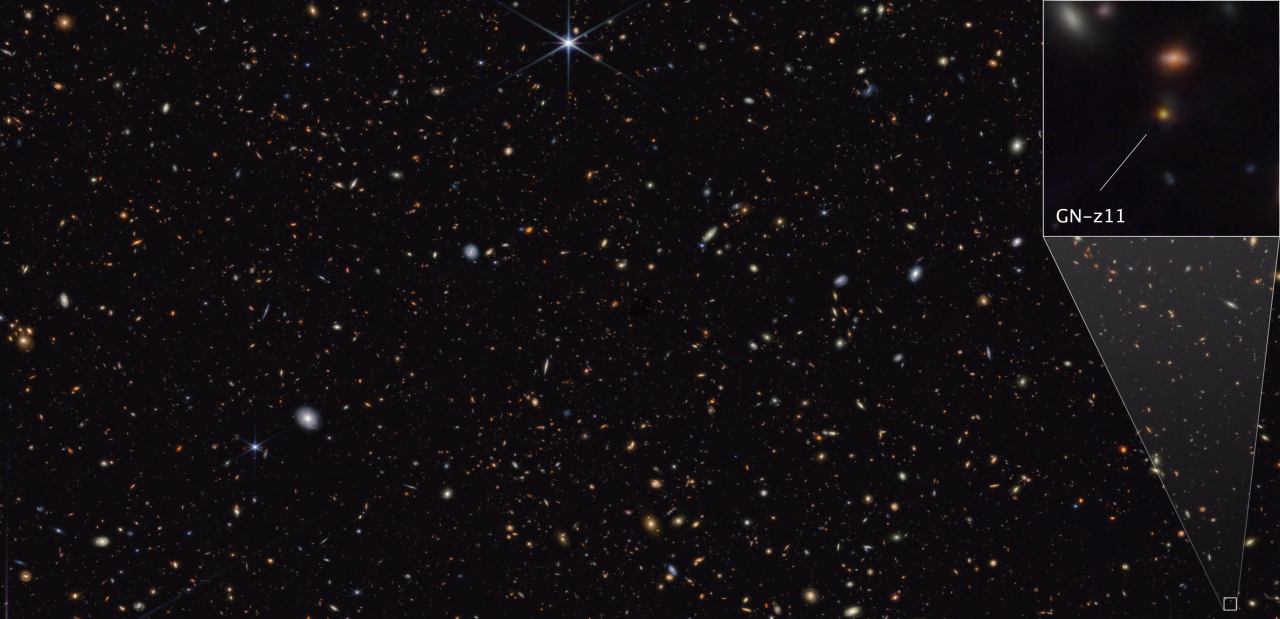Reviewed by Lexie CornerMar 5 2024
Probing into the depths of space and time, two research teams have utilized NASA’s James Webb Space Telescope to examine the remarkably bright galaxy GN-z11. This galaxy existed when the universe, which is currently 13.8 billion years old, was just approximately 430 million years old.
 This image from NASA’s James Webb Space Telescope NIRCam (Near-Infrared Camera) instrument shows a portion of the GOODS-North field of galaxies. At the lower right, a pullout highlights the galaxy GN-z11, which is seen at a time just 430 million years after the Big Bang. The image reveals an extended component, tracing the GN-z11 host galaxy and a central compact source whose colors are consistent with those of an accretion disk surrounding a black hole. Image Credit: NASA, ESA, CSA, Brant Robertson (UC Santa Cruz), Ben Johnson (CfA), Sandro Tacchella (Cambridge), Marcia Rieke (University of Arizona), Daniel Eisenstein (CfA).
This image from NASA’s James Webb Space Telescope NIRCam (Near-Infrared Camera) instrument shows a portion of the GOODS-North field of galaxies. At the lower right, a pullout highlights the galaxy GN-z11, which is seen at a time just 430 million years after the Big Bang. The image reveals an extended component, tracing the GN-z11 host galaxy and a central compact source whose colors are consistent with those of an accretion disk surrounding a black hole. Image Credit: NASA, ESA, CSA, Brant Robertson (UC Santa Cruz), Ben Johnson (CfA), Sandro Tacchella (Cambridge), Marcia Rieke (University of Arizona), Daniel Eisenstein (CfA).
First spotted using NASA’s Hubble Space Telescope, this galaxy—among the youngest and farthest ever witnessed—shines so brightly that it presents a challenge for researchers wanting to understand its luminosity. Currently, GN-z11 is beginning to reveal some of its mysteries.
Vigorous Black Hole is Most Distant Ever Found
A team analyzing GN-z11 using the Webb telescope has discovered the initial compelling evidence indicating that the galaxy is harboring a central, supermassive black hole that is swiftly accumulating matter. This discovery denotes the most distant active supermassive black hole ever identified.
We found extremely dense gas that is common in the vicinity of supermassive black holes accreting gas. These were the first clear signatures that GN-z11 is hosting a black hole that is gobbling matter.
Roberto Maiolino, Principal Investigator, Cavendish Laboratory, Kavli Institute of Cosmology, University of Cambridge
The team used Webb and also detected signs of ionized chemical elements commonly found close to accreting supermassive black holes. They also identified a very strong wind being ejected by the galaxy. These high-speed winds are usually produced by mechanisms linked to actively accreting supermassive black holes.
Webb’s NIRCam (Near-Infrared Camera) has revealed an extended component, tracing the host galaxy, and a central, compact source whose colors are consistent with those of an accretion disk surrounding a black hole.
Hannah Übler, Study Investigator, Cavendish Laboratory, Kavli Institute of Cosmology, University of Cambridge
This evidence indicates that GN-z11 contains a supermassive black hole with a two-million-solar mass, which is in a highly active phase of devouring matter. This activity, in turn, causes the galaxy's exceptional brightness.
Pristine Gas Clump in GN-z11’s Halo Intrigues Researchers
A second research team, also under the leadership of Maiolino, employed Webb’s Near-Infrared Spectrograph (NIRSpec) to locate a gaseous cluster of helium in the halo adjacent to GN-z11.
The fact that we don't see anything else beyond helium suggests that this clump must be fairly pristine. This is something that was expected by theory and simulations in the vicinity of particularly massive galaxies from these epochs—that there should be pockets of pristine gas surviving in the halo, and these may collapse and form Population III star clusters.
Roberto Maiolino, Principal Investigator, Cavendish Laboratory, Kavli Institute of Cosmology, University of Cambridge
Discovering the elusive Population III stars, which represent the initial generation of stars shaped primarily from helium and hydrogen, is a crucial goal of contemporary astrophysics. These stars are believed to be extremely massive, hot, and luminous. Their distinct characteristics include the existence of ionized helium and the lack of chemical elements denser than helium.
The emergence of the first galaxies and stars signifies a pivotal moment in cosmic history, where the universe transitioned from a dark and fairly simple state into the intricately structured and multifaceted environment we observe at present.
Webb observations in the future by Maiolino and team will delve deeper into GN-z11, hoping to bolster the evidence for the Population III stars that may be developing within its halo.
The study on the untouched gas clump in the halo of GN-z11 has been accepted for publication by Astronomy & Astrophysics. Meanwhile, the findings from the exploration of GN-z11’s black hole were reported in Nature on January 17th, 2024. These discoveries were made possible through the JWST Advanced Deep Extragalactic Survey (JADES), a collaborative effort between the NIRSpec and NIRCam teams.
Journal Reference:
Maiolino, R., et al. (2024) A small and vigorous black hole in the early Universe. Nature. doi:10.1038/s41586-024-07052-5.